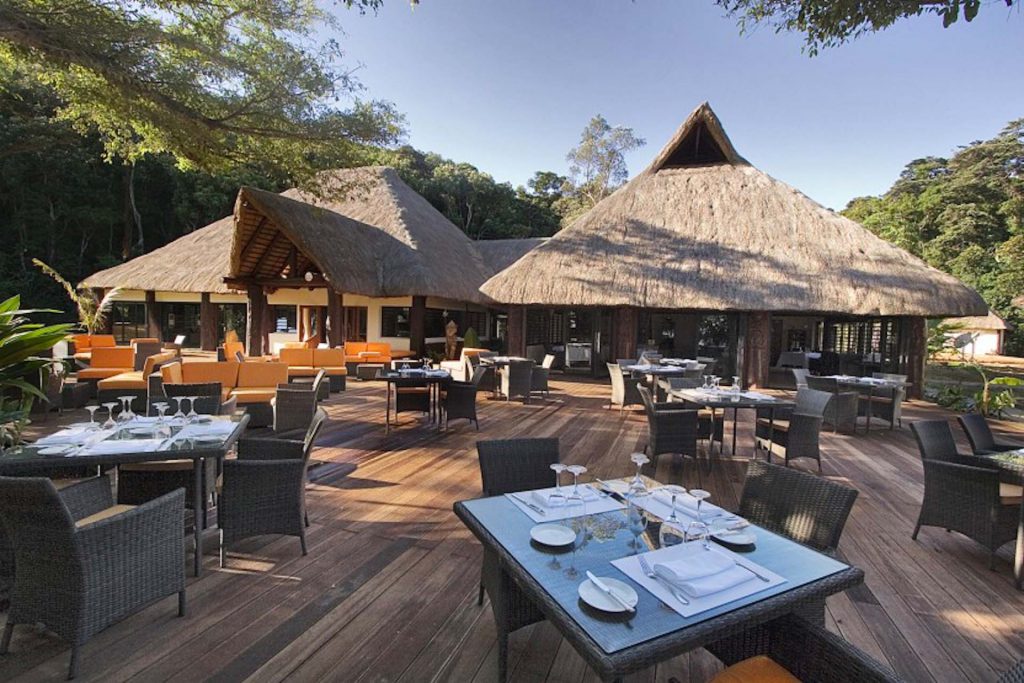A hotel integrated in the landscape
The Kanua Tera was built like a Melanesian village using local materials and ancestral techniques. It also complies with the principles of biological architecture.
The Kanua Tera: a model of sustainable tourism
An impressive traditional hut accommodates the lobby, the reception, the bar and the restaurant. The hotel has a total of 18 bungalows, including 14 new maisonettes and 4 traditional Kanak bungalows. The Ka Mâ (meaning ‘under the shadow of a banyan tree’) restaurant serves local dishes and seafood plateaus are made available by local fishermen upon request. Created and managed by the SOH, the Kuana Tera eco-lodge applies the concepts of ‘sustainable tourism’. To maintain a 3-star hotel facility in a preserved and wild nature, vehicles are not allowed on the site and there is no air-conditioning. Works and land clearing have been limited to a strict minimum and a replanting of the land along the lagoon – which is a UNESCO World Heritage Site – with endemic species has been conducted under the supervision of the Environment Directorate. In the same line of thought, waste water is disposed through a lagooning system, organic wastes are composted or recycled and finally, priority is given to the use of non-toxic materials.
Management of the eco-lodge by the tribe
Besides the efforts to preserve the remarkable site where the hotel is implanted, the local traditions and customs are respected. Relationships are particularly tense between some communities in the Grand Sud (Great South) region and Val Inco, the chemical plant for the treatment of nickel. And the setting up of the eco-lodge is a reminder that the plant is not the only employment provider and that tourism is a promising sector. The Kanua Tera is a probing example, providing employment to 18 people from the three tribes in Yate. Apart from being involved in construction works, the provision of materials, vegetable and fruit garden cultivation and the maintenance of the hotel, local craftsmen are also employed as guides by the hotel. Excursions on offer focus on making the Melanesian culture more accessible to visitors with hikes, fishing, diving or kayak outings, guided visits to ‘forbidden’ places (sacred places for the tribe) and also visits to the craft market of Yate. However, jet ski facilities should be made available in the near future, which doesn’t fit with the global approach of the eco-lodge, even if all the outings will be supervised and led by a state-certified instructor.
Efforts to open up the Great South
Renovation and extension works at the Kanua Tera have taken two years and cost nearly 600 million French Pacific Francs, financed in part by the owners, the Attiti family, the SOH, the South Province and the Institute for Participation of New Caledonia. This substantial investment is, however, legitimate to ensure the long-term viability of an economic activity which contributes not only to the opening up of the Grand Sud and the sharing of added value, but also to the reduction of the urban migration of tribes.
A fantastic place to practice sustainable sea activities
Along a wild small bay with a very nice sandy beach , the Kanua Tera remains at a strategic place for those who are delighted by all kind of sea nature activities.
Les Aiguilles de Prony
If you check on a map, it appears that the hotel is very close or example by sea from what is considered by professional divers as the best Caledonian diving spot: Les Aiguilles de Prony.
This worldwide geological particularism allows free and bottle divers to discover enormous stalagmites which are created by chemical precipitation at places where thermal fresh water and sea water mixed . Marine life around this 25 meters high stalagmites is great and atmosphere is unique. If you consider that the famous Hollywood filmmaker Luc Besson came to this place for his film Atlantis, you will understand that swimming or diving around this place can be a must for those who are in love with astonished undersea pictures.
The Humpback whales’ passage
Another particularism of this location is the annual visit made by inhabitants of the Antarctic: the Humpback whales during the austral winter time, from July until middle September. Whales come, visit and stay in the Prony Bay and surroundings since the old times. These cetaceans were completely part of the Kanaks life until a short time ago. We can still find sculptures or drawings representing them at different places in the traditional fares. The Humpback Whales leave the Antarctic visit and stay in different islands of the South Pacific where they give birth. This means that Humpbacks whales are able to appear at a swimming distance of the Kanua Tera’s shore. You can also observe them from the around mountains summits or better from the deck of a renting boat that you can easily book.
If you go to Prony’s Bay, don’t forget to visit the old village which was in the old time a place where prisoners in charge of woodcutting were living. Touching place!
The Kanua Tera’s shore can also be the starting point of very nice kayaking trips along the coast. You can rent the canoes directly at the beach’s hut of the Ecolodge. If whales are not far, this is also an opportunity to approach them in a sustainable way.




